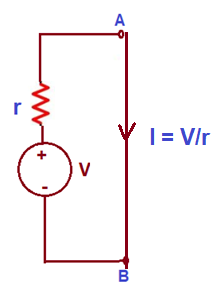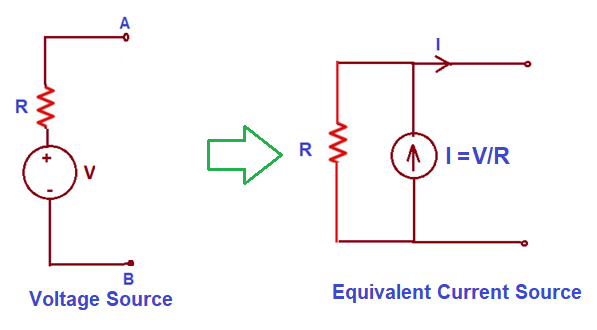Source Transformation is a technique to convert one kind of source into other. There are two types of sources: Voltage source and Current Source. Therefore, this technique will convert voltage source into equivalent current source and current source into equivalent voltage source. This kind of transformation is required to solve circuit network. Here, the sources refer to practical source. In this article, we will discuss the technique of Source Transformation using some examples.
Transformation of Voltage Source into Current Source:
A voltage source is represented by an ideal source connected with series internal resistance. To convert this voltage source into equivalent current source, first of all, we short the terminals A &B as shown in figure below. Find the current through the shorted terminals. Let this current be I.

I = V / r where V is the source voltage and r is the internal resistance.
As a current source is represented by an ideal source connected in parallel with air impedance/resistance, therefore, to get the equivalent current source, we connect an ideal current source I (=V/r) in parallel with the internal resistance r. Equivalent current source is shown below.

The reason behind connecting a parallel resistance equal to current source resistance is to have equal open circuit voltage across the source. Note that this open circuit voltage across voltage as well as current source is equal to V in the above figure. Let us now consider some examples for better insight of the matter.
Example: Obtain an equivalent current source for the given voltage source:

Solution:
Let us first short terminals A & B and then find the current through the circuit. The current I through the circuit will be given as below.
I = V/R
= 10/5
= 2 A
This means, the equivalent current source should be capable of supplying 2 A of current. Hence strength of source will be 2 A. Again, the internal impedance / resistance of voltage source is 5 Ω, this resistance should be connected in parallel with the current source. Therefore, the equivalent current source is given as below.

Conversion of Current Source into Voltage Source:
To covert a current source into an equivalent voltage source, first of all, we calculate the voltage across the source. This calculated voltage is the magnitude of ideal voltage source. However, to get the equivalent voltage source, we connect an internal resistance (whose value is equal to the parallel resistance of the current source). Thus, the equivalent voltage source is given as below.

Let us understand this technique of source transformation using an example.
Example: Convert the following current source to equivalent voltage source.

Solution:
First of all, find the voltage across the terminals of the source while keeping the source terminal open. This voltage (V) is given as
V = IR
= 10×10
= 100 Volt
Thus, the strength of voltage source will be 100 V. The internal series resistance of this source will be equal to the resistance of current source i.e. 10 Ω. Therefore, equivalent voltage source is shown as below.

Hope your concept of technique of source transformation is clear. In case you have any doubt, kindly write in the comment box. Thank you.
ntg